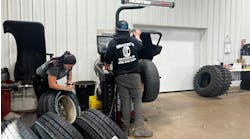In this MTD exclusive, Jason Lowing, general manager at Schneider Tire Outlet Inc., in Marne, Mich., and Robert Robbins, store manager at the Gills Point S Tire & Auto Service’s West Lebanon, N.H., location, discuss demand for all-weather tires in their markets and how to educate consumers about all-weather tires.
The all-weather benefit
To Lowing, all-weather tires are not a new tire segment. He says Schneider Tire Outlet has been selling all-weather tires for the past 20 years.
“To not have the full-on winter tire or full-on all-season tire that you’d have to store away makes a lot of sense, especially with the added benefits the all-weather tire gives you,” including enhanced safety and traction, he notes.
Robbins says his store has been open for about six years and has sold all-weather tires the whole time.
At Robbins’ location, all-weather tire sales are small, but he is seeing a steady rise.
Both dealers name the Nokian WR G4 as their best-selling all-weather tire.
“We see probably 90% of our all-weather tire sales come from this tire,” says Robbins, who explains that customers like the tire’s soft rubber compound. The tire “is pretty versatile.”
“It stays flexible in the cold temperatures, works well on the snow and ice and (is) not super-loud because of that soft compound.”
A growing segment
Lowing says that 10% of Schneider Tire Outlet’s passenger tire sales are all-weather tires and predicts that number is only going to grow.
“As technology gets better, these all-weather tires are becoming quieter, more comfortable and the traction is getting even better,” says Lowing.
He explains that “people in Michigan are buying snow tires before most people. They don’t want to store two sets of tires year-round. So this is the perfect solution for them.”
Robbins agrees that the all-weather segment will continue to grow and he believes customer education will be a big part of that growth.
“Also, we seem to be getting less snow every year that goes by. We’re not getting the snowstorms that we used to get, (which) drives people to only want to run one set of tires year-round.”
Qualifying the customer
Lowing and Robbins agree that customers are not as aware of all-weather tires as they are of all-season tires. This causes Lowing and Robbins — plus their teams — to put a little bit more effort into the all-weather sales.
“You do have to sell all-weather tires more because customers just aren’t aware,” says Lowing.
“They know what all-season tires are, but they’re not aware of all-weather tires. Once you take the time to explain the benefits and all the features, it’s not a hard sale. It just takes a little bit of extra work upfront.”
Robbins says a lot of his customers come in asking for all-season tires. He and his team always do a customer interview to determine the best product for that buyer’s vehicle. Robbins or one of his employees will walk out to the vehicle to see what they are currently driving on. Then they ask the customer specific questions.
“For example, we ask if they usually run winter tires or not,” explains Robbins.
“If they do, we ask if they like to run them late into the season or if they like to get them off early in the season. All that stuff comes into play when deciding if they are going to be a good all-weather candidate or not.”
Robbins finishes by saying he takes the customer back inside to show them all-weather tires versus all-season tires and lets the customer make the decision.
Lowing has a similar procedure in evaluating customers for all-weather tires.
“I start out by asking the customer what the most important thing to them is when it comes to tires,” he says.
“Is it longevity? A smooth, quiet ride? Traction? The all-weather tires are the safest tires we sell. So if a customer says that traction or safety are the biggest concerns for them, then we recommend all-weather tires.”
The all-weather tires are for “anyone who wants peace of mind, whether that be the soccer mom with a van full of kids or the 16-year-old who just got their license and is still figuring out the rules of the road,” he says.
Both Lowing and Robbins say the fourth quarter of the year is when all-weather tire sales really start to ramp up.
Whenever customers see snow, they usually become more aware of what they are driving on, explains Lowing, who also says that due to the boom in SUVs and crossover vehicle sales, customers want a tire that can “withstand pushing it to the limits.”
Long-term, the increase in all-weather tire sales may have an impact on snow tires, according to Lowing.
“Summer-only tires won’t get affected since they are more for performance vehicles,” he says.
“However, snow tires, I think, will take a small hit. It is hard to gauge season-to-season weather and how much snow we will get for tire dealers to correctly order inventory for snow tires. Plus, there seems to be a scaling back on manufacturers making snow-only tires.”





